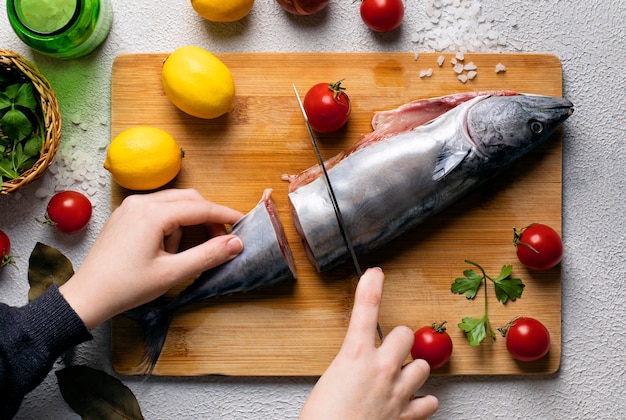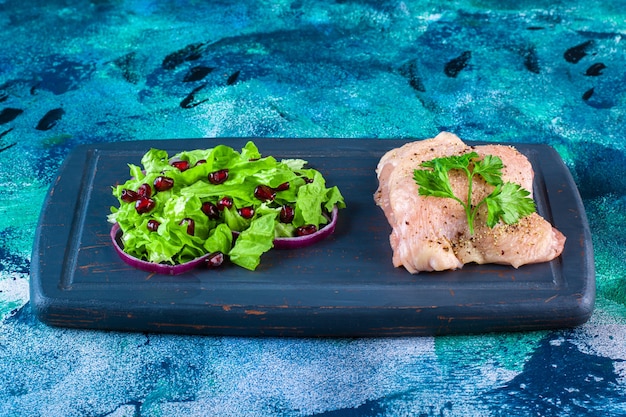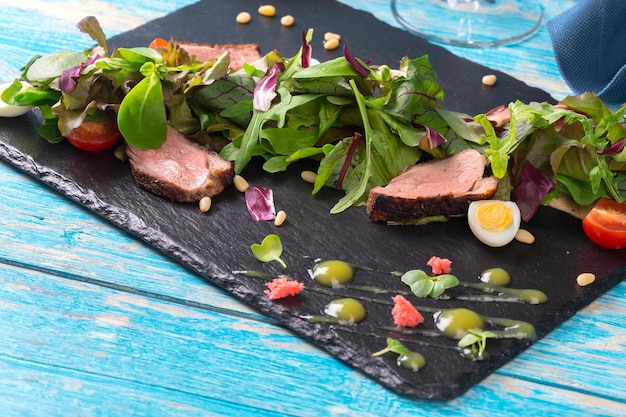Okay, let's talk about bluefin tuna. You might be thinking, "Isn't that, like, super expensive?" And you'd be right, it can be. But trust me, it's worth it. Bluefin tuna is truly special. The flavour is rich and bold, unlike anything else. It's an experience, you know? And hey, sometimes you just want to treat yourself, right?
I've had the pleasure of working with bluefin tuna a few times, and each experience has been unforgettable. It's a fish that demands respect. You don't want to overcook it, you want to let its natural flavour sing.
So, whether you're a seasoned chef or just starting out, I'm going to share some of my favourite bluefin tuna recipes. I'll also share some tips and tricks I've picked up along the way, so you can get the most out of this incredible fish. Let's dive in!
(Part 1) Sashimi and Nigiri: The Classic Approach

Let's start with the basics. Sashimi and nigiri are the most traditional ways to experience bluefin tuna. These dishes showcase the fish's natural flavour and texture, with minimal fuss. It's a culinary masterpiece in its simplest form.
1.1 Understanding the Cuts
There are different cuts of bluefin tuna used for sashimi and nigiri. Each has its unique flavour and texture:
- Maguro (赤身) - Lean Red Tuna: This is the most common cut, prized for its lean texture and rich, meaty flavour. It's often described as having a "meatiness" that resembles beef.
- Chutoro (中トロ) - Medium Fatty Tuna: This cut has a more buttery texture and a more pronounced, almost sweet, flavour. It's a real treat.
- Toro (大トロ) - Fatty Tuna: This is the most prized cut, known for its melt-in-your-mouth texture and intensely rich, umami flavour. It's often described as "luxurious."
1.2 Sashimi: The Art of Simplicity
Sashimi is simply thin slices of raw fish served with a side of soy sauce, wasabi, and pickled ginger. The key to good sashimi is the quality of the tuna and the sharpness of the knife. You want the slices to be translucent and even.
A Little Tip: When you're slicing, aim for a slight angle, as this helps release the tuna's natural oils.
1.3 Nigiri: A Culinary Dance
Nigiri is a bit more involved, with the tuna being placed on top of a small mound of vinegared rice. A dab of wasabi is placed between the fish and the rice. It's a delicate balance of flavour and texture.
Tip: When making nigiri at home, make sure the rice is well-seasoned and slightly warm. This will help the fish adhere to the rice.
A Personal Experience: I remember the first time I tried nigiri with Toro. It was like a revelation. The richness of the fat melted in my mouth, and the flavours just exploded. It was truly unforgettable.
(Part 2) From the Grill to Your Plate: A Smoky Delight

Bluefin tuna is fantastic grilled. The smoky flavour and charred edges add another layer of complexity to the fish. Plus, it's a great way to impress your friends.
2.1 choosing the right cut
For grilling, thicker cuts of bluefin tuna are ideal. Think steaks or fillets, about 1-2 inches thick. This will help ensure the tuna cooks evenly and retains its juicy texture.
A Little Tip: If you're using a thinner cut, consider making a "tuna sandwich" by grilling two slices together. This will help create a more substantial piece of fish.
2.2 Seasoning and Grilling Techniques
Keep it simple with your seasonings. Salt and pepper are all you really need. A squeeze of lemon juice just before serving adds a touch of brightness.
As for grilling, a hot grill is key. You want to sear the tuna quickly, creating a beautiful crust while keeping the inside rare to medium-rare. Just a few minutes per side is all you need.
A Little Tip: Use a fish spatula to flip the tuna, as it's more delicate than other meats.
2.3 Rest and Serve
Let the tuna rest for a few minutes before slicing it. This will allow the juices to redistribute, resulting in a more tender and flavourful dish.
Serve your grilled bluefin tuna with a simple salad, roasted vegetables, or a side of couscous.
A Personal Experience: One of my favourite ways to enjoy grilled bluefin tuna is with a side of grilled asparagus and a drizzle of olive oil. The smoky flavours of the tuna and asparagus complement each other perfectly.
(Part 3) Embrace the Pan: Pan-Seared Perfection

If you're not a grill enthusiast, don't worry. You can achieve incredible results with a pan. Pan-searing allows you to create a crispy exterior while keeping the inside tender and juicy.
3.1 The Right Pan and Temperature
Use a heavy-bottomed pan, like cast iron or stainless steel. Heat it over medium-high heat. You want the pan to be hot enough to sear the tuna quickly without burning it.
A Little Tip: Test the heat of the pan by adding a drop of water. If it sizzles and evaporates quickly, the pan is ready.
3.2 Sealing and Finishing
Season the tuna with salt and pepper. Add a little bit of oil to the hot pan and sear the tuna for about 1-2 minutes per side. You'll know it's ready when the tuna is nicely browned and the edges are slightly caramelized.
Remove the tuna from the pan and finish it off in the oven, if you prefer a more cooked center. Bake it at 350°F (175°C) for 5-7 minutes, depending on how you like it cooked.
3.3 Serving with Style
Serve pan-seared bluefin tuna with a side of roasted potatoes, sautéed mushrooms, or a creamy sauce.
A Personal Experience: One time, I pan-seared bluefin tuna and served it with a lemon-butter sauce and a side of sautéed spinach. The tangy sauce and the buttery spinach paired beautifully with the rich flavour of the tuna.
(Part 4) Exploring the World of Marinades
Marinades can add a whole new dimension to bluefin tuna. They can help tenderize the fish, enhance the flavour, and create a beautiful visual appeal.
4.1 Citrusy Delights
Lemon, lime, and orange zest are great for adding a bright, citrusy flavour to tuna. Combine them with olive oil, soy sauce, and fresh herbs like rosemary or thyme.
A Little Tip: Use the microplane grater to get the most zest from your citrus fruits.
4.2 Soy Sauce and Ginger Fusion
Soy sauce, ginger, and garlic create a classic Asian-inspired marinade. You can also add a touch of sesame oil for extra flavour.
A Little Tip: Use fresh ginger for the best flavour. Grate it finely or mince it.
4.3 Spice It Up
For a bolder flavour, try a marinade with chili flakes, cumin, and paprika. Be careful not to overdo it, as you don't want to mask the natural flavour of the tuna.
A Little Tip: Start with a small amount of spice and adjust to your taste.
4.4 Marination Time
Marinate the tuna for at least 30 minutes, or up to a few hours. For longer marination times, keep the tuna in the refrigerator.
A Little Tip: Flip the tuna halfway through the marination time to ensure even flavouring.
(Part 5) Beyond the Basics: Creative Recipes
Now that you have a solid understanding of the fundamentals of cooking bluefin tuna, let's explore some more creative and innovative recipes.
5.1 Bluefin Tuna Poke Bowls
Poke bowls are a fun and customizable dish featuring raw tuna, rice, and an array of toppings. You can add things like avocado, mango, edamame, seaweed salad, and your favourite sauces.
A Little Tip: Use sushi rice for the best texture.
A Personal Experience: One time, I made a bluefin tuna poke bowl with avocado, mango, cucumber, seaweed salad, and a drizzle of sriracha mayo. It was a delicious and refreshing meal.
5.2 Bluefin Tuna Tartare
Bluefin Tuna Tartare is a sophisticated dish that's perfect for a special occasion. It's made with finely chopped raw tuna, mixed with capers, shallots, lemon juice, and olive oil. Serve it with crackers, toast, or crostini.
A Little Tip: Use a sharp knife to chop the tuna as finely as possible.
5.3 Bluefin Tuna Tacos
Tacos are a great way to enjoy bluefin tuna. You can grill or pan-sear the tuna and add it to your favourite taco fillings. Try a combination of pickled onions, cilantro, avocado, and a spicy crema.
A Little Tip: Use soft corn tortillas for the best tacos.
(Part 6) Tips for Success: A Culinary Guide
Here are a few tips to help you achieve the best results when cooking bluefin tuna:
- Quality Matters: Always use fresh, high-quality tuna. It's worth investing in the best you can afford.
- Don't Overcook It: Bluefin tuna is best cooked rare to medium-rare. Overcooked tuna will be dry and tough.
- Sharp Knife Is Key: A sharp knife is essential for slicing tuna evenly and cleanly.
- Rest the Tuna: Let the tuna rest for a few minutes after cooking. This allows the juices to redistribute, making it more tender and flavourful.
- Get Creative with Sauces: Don't be afraid to experiment with different sauces and toppings. Bluefin tuna can handle a lot of flavour.
(Part 7) Bluefin Tuna: A Sustainable Choice?
It's important to be mindful of sustainability when choosing bluefin tuna. Overfishing has had a significant impact on bluefin tuna populations, so it's crucial to support sustainable fishing practices.
Look for tuna that is certified by reputable organizations, such as the Marine Stewardship Council (MSC). These organizations ensure that the tuna is caught in a way that does not harm the environment or the tuna population.
A Little Tip: Ask your fishmonger about the source of their tuna. They should be able to tell you whether it's sustainably caught.
(Part 8) FAQs: Your Questions Answered
8.1 What is the best way to store bluefin tuna?
For the best flavour and texture, store bluefin tuna in the refrigerator, wrapped tightly in plastic wrap. It will keep for 1-2 days.
8.2 Can you freeze bluefin tuna?
Yes, you can freeze bluefin tuna. Wrap it tightly in plastic wrap and then in foil, and store it in the freezer for up to 3 months.
8.3 What is the difference between bluefin tuna and other tuna species?
Bluefin tuna is known for its rich flavour, buttery texture, and high fat content. Other tuna species, like yellowfin and albacore, have a leaner texture and a milder flavour.
8.4 How do I know if bluefin tuna is fresh?
Fresh bluefin tuna should have a bright red colour, a firm texture, and a mild, slightly sweet smell.
8.5 Is bluefin tuna safe to eat raw?
Yes, bluefin tuna is safe to eat raw when it comes from a reputable source and is properly handled. However, it's always best to err on the side of caution and cook it to a safe internal temperature if you're unsure.
(Part 9) The Final Word
Cooking bluefin tuna is an experience that's sure to elevate your culinary game. Whether you're a seasoned chef or just starting out, the key is to respect the fish and its unique qualities. Use the right techniques, experiment with different flavours, and enjoy the incredible taste of this premium fish.
Happy cooking!
Everyone is watching

Corn on the Cob: The Ultimate Guide to Perfectly Cooked Ears
Healthy MealsAh, corn on the cob. Just the name evokes images of sunny days, barbecues, and that sweet, juicy flavour that ...

Scallops: The Ultimate Guide to Perfect Cooking
Healthy MealsAh, scallops. Those delicate, sweet, and utterly delicious morsels of the sea. They hold a special place in my...

Spaghetti Squash: The Ultimate Guide to Cooking and Serving
Healthy MealsRemember that time you saw spaghetti squash at the supermarket, looking all bumpy and strange, and thought, "W...

Salmon Cooking Times: Perfect Guide for Every Recipe
Healthy MealsLet me tell you, cooking salmon is an art form. It's all about getting that perfect balance: juicy and tender,...

Ham Cooking Time: How Long to Bake, Smoke, or Boil a Delicious Ham
Healthy MealsAh, ham. It's a classic, isn't it? A real crowd-pleaser, especially around holidays. And when done right, it'...
